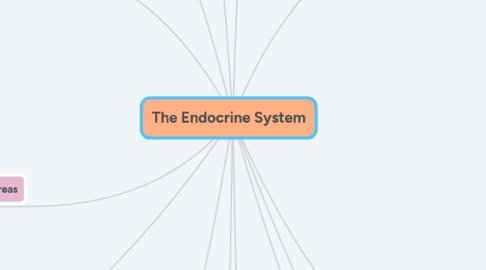
1. Pineal Gland
1.1. Hangs from the third ventricle of the brain
1.1.1. Pinealocytes
1.1.1.1. Melatonin
1.1.1.1.1. Timing of sexual maturation and puberty
1.1.1.1.2. Day/Night cycles
1.1.1.1.3. Body temperature, sleep, appetite
1.1.1.1.4. Production of antioxidant and detoxification molecules in cells
2. Thyroid Gland
2.1. Inferior to the Larynx
2.1.1. Follicle Cells
2.1.1.1. Thyroxine-- T4 & Triiodothyronine-- T3
2.1.1.1.1. Hyposecretion: Adults- Myxedema; Infants- Cretinism
2.1.1.1.2. Hypersecretion: Graves' Disease
2.1.2. Parafollicullar Cells
2.1.2.1. Calcitonin
2.1.2.1.1. Antagonist to Parathyroid Hormone (PTH)
3. Parathyroid Gland
3.1. Sits on the posterior side of the thyroid gland
3.1.1. Typically 4 glands
3.1.1.1. Parathyroid Hormone (PTH)
3.1.1.1.1. Increases Ca+2 in the blood
3.1.1.1.2. Decreases PO4^-2 in the blood
3.1.1.1.3. Acts on bones kidneys & intestines
3.1.1.1.4. Hyperparathyroidism: due to tumor-- bones soften; kidney stones
3.1.1.1.5. Hypoparathyroidism: following trauma, magnesium deficiency-- tetany, respiratory paralysis & death
4. Pancreas
4.1. Inferior to the stomach
4.1.1. Endocrine Functions
4.1.1.1. Hormones into body fluids
4.1.1.2. Alpha Cells
4.1.1.2.1. Glucagon
4.1.1.3. Beta Cells
4.1.1.3.1. Insulin
4.1.1.4. Delta Cells
4.1.1.4.1. Somatostatin
4.1.2. Exocrine Functions
4.1.2.1. Acinar Cells
4.1.2.1.1. Digestive juices through ducts
5. Ovaries
5.1. Placenta
5.1.1. Estrogen
5.1.1.1. Maturation of reproductive organs
5.1.1.2. Appearance of secondary sexual characteristics
5.1.2. Progesterone
5.1.2.1. Breast development
5.1.3. Human Chorionic Gonadotropin (hCG)
5.2. Lower pelvic region
6. Heart
6.1. Atrial Natriuretic Peptide (ANP)
6.1.1. Decreases blood Na+ concentration-- Blood pressure and blood volume
7. Kidneys
7.1. Erythropoietin
7.1.1. Signals production of red blood cells
7.2. Renin
7.2.1. Initiates the renin-angiotensin-aldosterone mechanism
8. Hypothalamus
8.1. Middle of the brain
8.1.1. Controls the Endocrine system
8.1.1.1. Releasing hormones
9. Pituitary Gland-- Master Gland
9.1. Lies in the Sella Turcica of the sphenoid bone
9.1.1. Anterior Lobe--Adenohypophysis: Made of glands
9.1.1.1. Thyroid Stimulating Hormone (TSH--Thyrotropin)
9.1.1.1.1. Stimulates secretion of thyroid hormones (T3 & T4) from thyroid gland
9.1.1.2. Growth Hormone (GH)
9.1.1.2.1. Stimulates cells to enlarge and divide rapidily
9.1.1.2.2. Increase amino acid uptake and protein synthesis
9.1.1.2.3. Decrease rate of carbohydrate usage
9.1.1.2.4. Increases rate of fat usage
9.1.1.3. Prolactin (PRL)
9.1.1.3.1. Promotes milk production in females
9.1.1.3.2. Uncertain function in males
9.1.1.4. Adrenocorticotropic Hormone (ACTH)
9.1.1.4.1. Stimulates secretion of cortisol and other glucocorticoids from adrenal cortex
9.1.1.5. Follicle-stimulating Hormone (FSH)
9.1.1.5.1. Causes growth and development of ovarian follicles in females
9.1.1.5.2. Causes growth and development of sperm production in males
9.1.1.6. Luteinizing Hormone (LH)
9.1.1.6.1. Causes ovulation in females
9.1.1.6.2. Causes sex hormone production in both male and females
9.1.2. Posterior Lobe--Neurohypophysis: Made of Neurons
9.1.2.1. Antidiuretic Hormone (ADH)-- Vasopressin
9.1.2.1.1. Prevents urine formation
9.1.2.1.2. Regulates water balance
9.1.2.1.3. Triggered by pain, low blood pressure and drugs
9.1.2.1.4. High amounts cause Vasoconstrition
9.1.2.2. Oxytocin
9.1.2.2.1. Stimulant of urine contraction
9.1.2.2.2. Neurotransmitter-- "Cuddle Hormone"
9.1.2.2.3. Trigger for milk ejection
10. Thymus
10.1. Inferior to the heart
10.1.1. Thymosis
10.1.1.1. Stimulate the development of antibodies
10.1.2. Thymulin
10.1.2.1. Generates T-lymohocytes
10.1.2.1.1. White blood cells that fight infections and destroy abnormal cells
10.1.3. Thymopoientins
10.1.3.1. Affects the rate at which your skin ages
11. Adrenal Gland-- Supra-renal glands
11.1. Connected to the pancreas
11.1.1. Adrenal Cortex
11.1.1.1. Steroid Hormones
11.1.1.1.1. Zona Glomerulosa
11.1.1.1.2. Zona Fasciculata
11.1.1.1.3. Zona Reticularis
11.1.2. Adrenal Medulla
11.1.2.1. Amine Hormones
11.1.2.1.1. Epinephrine-- Adrenaline 80%
11.1.2.1.2. Norepinephrine-- Noradrenalin 20%
12. Testis
12.1. Pelvic Region
12.1.1. Testosterone
12.1.1.1. Necessary for sperm production
12.1.1.2. Change in appearance of males secondary sexual characteristics
12.1.1.3. Gives males a sex drive
13. Digestive System Cells
13.1. Gatrin
13.1.1. Stimulates the release of HCl
13.2. Secretin
13.2.1. Stimulates liver and pancreas
13.3. Serotonin
13.3.1. Acts as a paracrine
13.4. Cholecystokinin
13.4.1. Stimulates pancreas, gallbladder and sphincter

